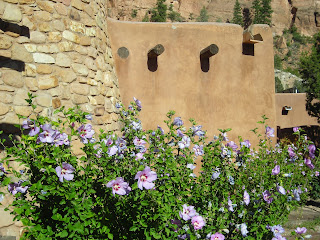I left Durango and drove the lovely route 550 through the mountains of Colorado. As I descended I began to encounter the red rock and earth that I had seen on earlier parts of my trip. Then I came upon the beautiful Chama Valley, near Abiquiu, NM. I planned on staying at the Abiquiu Inn (http://www.abiquiuinn.com/), near the monastery. In 1997 I stayed here for the first time.
Before arriving at the Inn I passed the Echo Amphitheater (http://www.digitalabiquiu.com/pages/tours/echo_t.html), near Ghost Ranch (http://www.ghostranch.org/?utm_source=google&utm_medium=cpc&utm_campaign=cpc-adwords-event-calendar-2010), the famous residence of the artist Georgia O’Keefe (http://www.georgia-okeeffe.com/ghost-ranch.html). This whole are is filled with different kinds of artists and they are having a special showing of different ateliers in the area the first week of September. The Inn is typical of the adobe construction here. It is truly amazing that the temperatures inside can be almost twenty degrees cooler than outside. The evenings can be cold and each apartment at the Inn has a gas adobe fireplace.
Christ in the Desert Monastery (http://www.christdesert.org/) is off of the main road some 13 miles in the middle of a National Forest area, along the Chama River. In bad weather, the road is nearly impassable, but it has been recently repaired after several washouts, and is now nice and dry and hard. It is dirt and gravel, so it is very much open to the elements.
The Monastery was designed by the a Japanese architect to fit in with the area. It is very simple and beautiful, providing spectacular views of the canyon walls behind it. At the top of the mesa you can see three crosses, where the monks hike during Holy Week.
One of my work assignments while here was to help harvest the hops for Monks Ale! I’m glad I visited the Budweiser brewery while I was in St. Louis so I had some knowledge of what they are used for. It was a wonderfully relaxing morning spent under the shade of a huge cottonwood tree down by the river with several other monks and friends from nearby.
On September 6th I left the Monastery early and made the trip to the Sangre de Cristo Center (http://www.sangredecristo.org/) in Santa Fe., NM. Since I had just finished reading Death Comes for the Archbishop, by Willa Cather, it was a particular delight to see the old cathedral (http://www.cbsfa.org/home0.aspx) in the center of town which I came upon while looking for someplace to wash my car. As soon as I get situated at Sangre, I will send more news. The day I arrived here was Labor Day and most things were closed.

























No comments:
Post a Comment